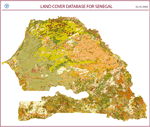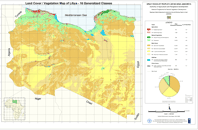FAO - Africover
Type of resources
Available actions
Topics
Keywords
Contact for the resource
Provided by
Formats
Representation types
Update frequencies
status
Scale
-

The land cover has been produced from visual interpretation of digitally enhanced LANDSAT ETM images (Bands 4,3,2) acquired mainly in the year 2000-2005. The land cover classes have been developed using the FAO/UNEP international standard LCCS classification system. The land cover legend of Senegal, consisting of 55 classes, was set up using the F.A.O. LCCS methodology. To affine the interpretation, a set of aerial photos donated by USGS and the high resolution images of Google Earth have been used. The mapping scale used for the visual photo-interpretation was 1:100.000. The full resolution version of the Land Cover dataset consists of 23,922 polygons, covering an area of 19,659 thousands ha. There is also an aggregated version generated on the basis of a spatial criteria, which produces about the 11% reduction of the total amount of polygons. The spatially aggregated dataset (available for download) consists of 21,238 polygons. The Senegal Land Cover mapping was carried out in the framework of Global Land Cover Network (GLCN) activities.
-

This data set is a re-aggregated version of the full resolution Libyan land cover database. The original full resolution data has been concentrated in few generalized classes highlighting the most relevant features mapped without loosing information. The result is an aggregation of 10 generalized classes listed below, which keeps a good level of information, giving at the same time an exact estimation of the areas covered by each aggregated class. The 10 Generalized Classes aggregation Land Cover map of Libya: AGRICULTURE AI - Irrigated Agriculture AR - Rainfed Agriculture NATURAL VEGETATION NF - Natural Forest and Reforestations NV - Rangeland BARE AREAS BC - Bare Soil Consolidated BU - Bare Soil Unconsolidated BSn - Loose and Shifting Sand BW - Bare Soil in Wadi Environment SABKHAS SK - Terrestrial and Aquatic Sabkha Environment and Waterbodies URBAN AREAS UB - Urban areas, Quarries and Dump Sites The land cover products were developed by FAO as part of the LIB/00/04 'Mapping of Natural Resources for Agriculture Use and Planning Project in Libya'. This project was initiated by the Government of Libya, FAO and the United Nations Development Programme (UNDP) to strengthen the capacity of the General People's Committee for Agriculture, Animal and Marine Wealth (GAAAMW) to manage land resources at national and sub-national levels through the establishment of a strategy, and a spatially based operational decision support system - the Land Resources Information Management System (LRIMS).
 FAO Map Catalog
FAO Map Catalog